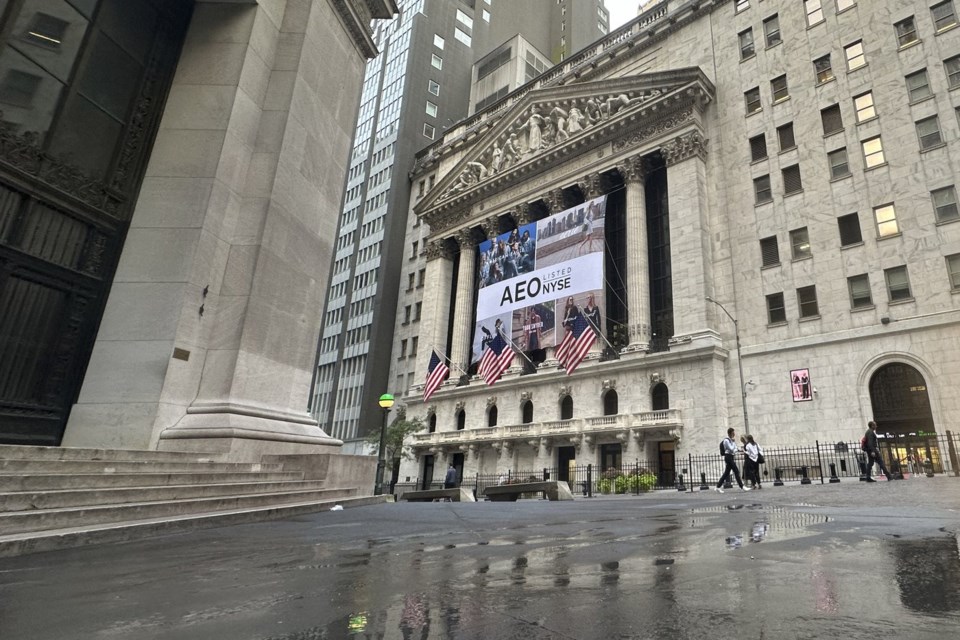NEW YORK (AP) — U.S. stocks drifted to a mixed close near their all-time highs ahead of a highly anticipated meeting of the Federal Reserve. The S&P 500 edged just barely higher Tuesday. The Dow Jones Industrial Average slipped less than 0.1%, pulling slightly below the record high it set a day earlier. The Nasdaq composite rose 0.2%, driven by gains for Big Tech companies including Microsoft and Intel. The mixed trading came as Wall Street continues to expect bigger-than-usual relief for the economy to arrive Wednesday through a cut to interest rates from the Fed. Treasury yields edged higher in the bond market.
THIS IS A BREAKING NEWS UPDATE. AP’s earlier story follows below.
NEW YORK (AP) — U.S. stocks are hanging near their records Tuesday, as Wall Street continues to expect relief for the economy to arrive Wednesday through a bigger-than-usual cut to interest rates.
The S&P 500 was virtually unchanged in afternoon trading and just 0.6% below its all-time high set in July, as of 2:25 p.m. Eastern time. The Dow Jones Industrial Average slipped 8 points, or less than 0.1%, from its own record set the day before, while the Nasdaq composite was up 0.2%.
Intel helped drive the market with a gain of 3.3% following a series of announcements, including an expansion of its partnership with Amazon Web Services to produce custom chips. Intel also detailed plans to build its foundry business.
Microsoft rose 0.9% after increasing its dividend and announcing a program to deliver up to another $60 billion to investors by buying back stock.
They helped offset a 2.5% drop for Philip Morris International, which said it expects to record a loss of $220 million against its third-quarter results because of the sale of its Vectura Group inhaled-therapeutics subsidiary.
The calm movements for the U.S. stock market overall are a sharp departure from prior weeks, during which the S&P 500 briefly fell nearly 10% below its all-time high. At the time, global markets were reeling on worries that a slowing U.S. economy could fall into a recession, along with some technical factors that forced hedge funds around the world to back out of a popular trade all at once.
Since then, excitement has built about an announcement scheduled for Wednesday afternoon from the Federal Reserve. The unanimous expectation on Wall Street is that the Fed will deliver the first cut to its main interest rate in more than four years.
Lower rates would make things easier for the economy, which has already begun to slow because it's become so expensive to borrow money for everything from houses to cars to corporate debt. The Fed has been keeping its main interest rate at a two-decade high in hopes of grinding down on the economy enough to stifle high inflation.
Now that inflation is down substantially from its peak two summers ago, the Fed believes it can shift its focus more toward protecting the job market and economy. The only question is by how much the Fed will cut rates to do so, and that is a delicate balancing act.
While lowering rates gives a boost to the overall economy and to financial markets, it can also give inflation more fuel. Some critics say the Fed is already moving too late to help the economy, while others warn of inflation staying stubbornly higher than it has in the past.
The general expectation on Wall Street is for the Fed to deliver a larger-than-usual cut of half of a percentage point on Wednesday, according to data from CME Group. But it's not a certainty. Traders are still betting on a 37% probability for a traditional-sized move of a quarter of a percentage point,
Economic reports released Tuesday did little to change those expectations. One said U.S. shoppers spent more at retailers last month than expected. That's an encouraging signal that the heart of the U.S. economy remains solid, but details underneath the surface were perhaps more discouraging. After ignoring automobiles and fuel, sales at U.S. retailers last month were a touch weaker than economists expected.
“This data isn’t going to decide the issue for the Fed, one way or the other,” Chris Larkin, managing director, trading and investing, at E-Trade from Morgan Stanley, said about the size of Wednesday's rate cut.
A separate report that came later in the morning said U.S. industrial production returned to growth in August and was stronger than economists expected.
In the bond market, the 10-year Treasury yield rose to 3.64% from 3.62% late Monday. The two-year yield, which more closely tracks expectations for the Fed’s actions, rose to 3.59% from 3.56%.
In stock markets abroad, Japan’s Nikkei 225 fell 1% as the value the Japanese yen ticks higher against the U.S. dollar.
The yen has been rising on expectations that the Bank of Japan will continue to head in the opposite direction of the Federal Reserve and keep raising interest rates. A stronger yen can hurt the profits of Japan’s big exporters.
Stock indexes rose across much of Europe, while markets were closed in mainland China and South Korea.
___
AP Business Writers Matt Ott and Elaine Kurtenbach contributed.
Stan Choe, The Associated Press




